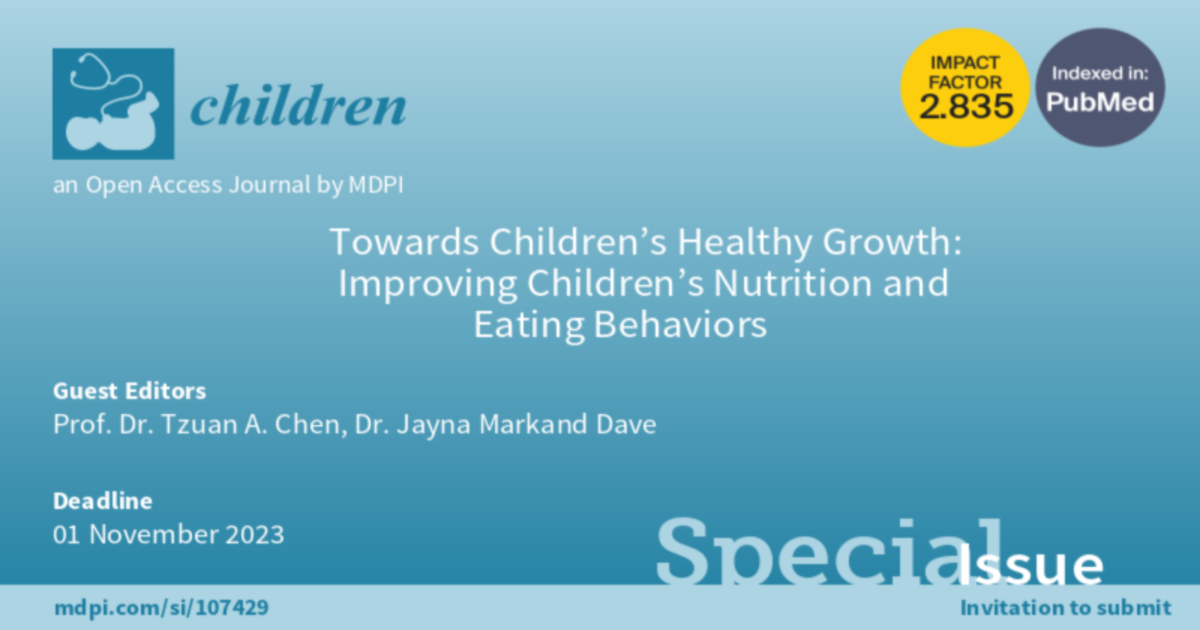Towards Children’s Healthy Growth: Improving Children’s Nutrition and Eating Behaviors
A special issue of Children (ISSN 2227-9067). This special issue belongs to the section "Global Pediatric Health".
Deadline for manuscript submissions: closed (1 November 2023) | Viewed by 32732

Special Issue Editors
2. Department of Psychological, Health, and Learning Sciences, College of Education, University of Houston, Houston, TX, USA
Interests: applying statistics; psychometrics in social-behavioral science; children/adult nutrition; health disparities; health behaviors; substance use; obesity; cancer prevention
Interests: health disparities; obesity; chronic disease; children and families; low-income underserved communities; food access; food choice; food insecurity; nutrition security; nutrition and health outcomes; community-engaged approaches to population health; design, implementation, and evaluation of interventions in preschool, schools, and family- and community-based settings
Special Issues, Collections and Topics in MDPI journals
Special Issue Information
Dear Colleagues,
Nutrition plays a vital role in children’s health. Childhood is a time of rapid growth and development with biologic, psychosocial, and emotional changes. These changes place elevated nutritional demands on children. The types of health behaviors; the influences of family and the environment; and cultural, socioeconomic, and psychological factors, can present barriers to healthy eating for children. Nutrition deficits and poor eating habits established in childhood have immediate and long-term adverse health, growth, and developmental consequences that might also be carried into adulthood.
This Special Issue of Children is focused on children’s nutrition, feeding, and eating behaviors, and their relationship to child health outcomes. This Special Issue is designed to document and disseminate original qualitative and/or quantitative research and emerging issues and practices relevant to these issues globally. For this Special Issue, we invite papers reporting:
- Original research studies focused on innovative interventions for improving children’s nutrition, feeding, or eating behaviors;
- Studies on conceptual models demonstrating the effect of children’s nutrition and eating behaviors on health and growth;
- Review articles that highlight the significance of recent research in child nutrition, feeding and eating behaviors and illustrate the central role of nutrition in the promotion of children’s health.
Prof. Dr. Tzuan A. Chen
Dr. Jayna Markand Dave
Guest Editors
Manuscript Submission Information
Manuscripts should be submitted online at www.mdpi.com by registering and logging in to this website. Once you are registered, click here to go to the submission form. Manuscripts can be submitted until the deadline. All submissions that pass pre-check are peer-reviewed. Accepted papers will be published continuously in the journal (as soon as accepted) and will be listed together on the special issue website. Research articles, review articles as well as short communications are invited. For planned papers, a title and short abstract (about 100 words) can be sent to the Editorial Office for announcement on this website.
Submitted manuscripts should not have been published previously, nor be under consideration for publication elsewhere (except conference proceedings papers). All manuscripts are thoroughly refereed through a single-blind peer-review process. A guide for authors and other relevant information for submission of manuscripts is available on the Instructions for Authors page. Children is an international peer-reviewed open access monthly journal published by MDPI.
Please visit the Instructions for Authors page before submitting a manuscript. The Article Processing Charge (APC) for publication in this open access journal is 2400 CHF (Swiss Francs). Submitted papers should be well formatted and use good English. Authors may use MDPI's English editing service prior to publication or during author revisions.
Keywords
- children
- nutrition
- feeding
- eating behaviors
- health outcomes
Benefits of Publishing in a Special Issue
- Ease of navigation: Grouping papers by topic helps scholars navigate broad scope journals more efficiently.
- Greater discoverability: Special Issues support the reach and impact of scientific research. Articles in Special Issues are more discoverable and cited more frequently.
- Expansion of research network: Special Issues facilitate connections among authors, fostering scientific collaborations.
- External promotion: Articles in Special Issues are often promoted through the journal's social media, increasing their visibility.
- e-Book format: Special Issues with more than 10 articles can be published as dedicated e-books, ensuring wide and rapid dissemination.
Further information on MDPI's Special Issue policies can be found here.







